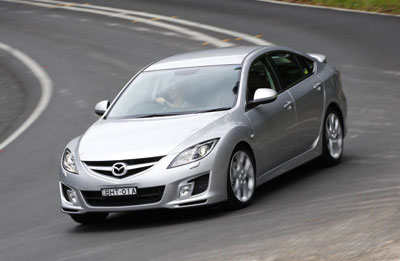Japanese car makers are certainly behind the eight ball when it comes to diesel passenger cars, at least here in Australia. Take a look at the small- and mid-sized hatch and sedan catalogues of Toyota, Honda, Mitsubishi, Nissan and Subaru, and compare that with the likes of Volkswagen, Peugeot, Renault, BMW and Mercedes-Benz. Even the Koreans are better represented over here.
Toyota has a Corolla oiler abroad, as does Mitsubishi with its Lancer, yet both are denied an Australian passport. The new-gen Mazda 3 diesel is also now delayed until some time next year. This makes the mid-sized 6 oiler, at $37,190 for the Diesel Classic wagon or $43,890 for the Diesel Sports hatch, the second-cheapest Japanese diesel passenger vehicle in Oz. Or the cheapest, if you discount the $36,990 Nissan X-Trail SUV.With 136kW and 400Nm from Mazda’s 2.2-litre turbo-diesel four, the 6 closely rivals the Merc C-Class’ 125kW/400Nm 2.1-litre turbo-diesel four. Unfortunate, then, that it’s only available as a six-speed manual and, at 1637kg, our Diesel Sports hatch test car also weighs 124kg more than the Luxury Sports hatch on which it’s based (the Diesel Sports is essentially a Luxo Sports without the sunroof).So with all the data downloaded, how does it all translate in the real world? Well, get past the slightly clattery idle and dulled throttle response, and the 6 diesel really starts to kick, revving to beyond 5000rpm without much stress or strain. Typical of a turbo-diesel, it’s swimming in a pool of mid-range torque, so in-gear punch is excellent. Yet you’re rarely frustrated by that typical diesel trait, the dreaded narrow power band, because the engine doesn’t fall into a gutter with churned guts if you run the revs too low or high. Only driveability from take off is an issue – don’t dial up enough revs and there’s a bit too much lag; dial too many, and you’ll anger the ESP gods as the front wheels try to dig a whole in the tarmac.Pleasingly, the heavier diesel donk doesn’t seem to affect the petrol 6’s finely balanced – actually, make that brilliantly balanced – chassis. There’s innate communication between steering and front wheels, minimal body roll, nicely intuitive ESP and good responses to throttle and brake. A harmonious blend of controls still defines the Mazda 6 as a driver’s car nestled within a conservative family-car genre. Like the accountant who plays first-grade footy.However the 6 does put a foot wrong when it comes to ride quality. On 18-inch alloys, it’s constantly restless and jiggly even on smooth bitumen. Interestingly, we drove to Mazda HQ in an MX-5 and drove home in the 6, and it was the little Mixxer that I thought had a superior ride. But it’s road noise that replaces ride quality as the issue on rough roads, because the 6 deals better with larger pot holes than small stuff, and shows good levels of discipline and body control. It just roars at you while it’s doing it.As it stands, though, the few blotches on the Mazda’s copy book can’t blemish a diesel that’s well worth having in the range, a gutsy move when most of the Japanese don’t bother.





